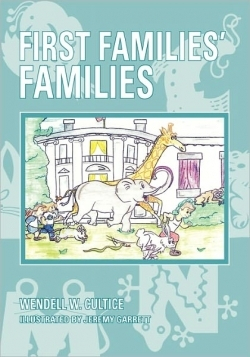First Families' Families
Practically all of the US presidents had pets; most were cats, dogs, and horses, but some of these pets were undomesticated animals. “John Quincy Adams received a pet alligator from the Marquis de Lafayette,” author Wendell W. Cultice writes.
The title of First Families’ Families refers to the First Families’ pets. This picture book devotes one page to the pets, or lack thereof, belonging to each of the US presidents, from George Washington to Barack Obama. Back matter includes a quiz and a bibliography.
Cultice, a historian with a special interest in US presidents, held positions as a school principal and teacher prior to his retirement. He is the author of several books, including Youth’s Battle for the Ballot: A History of Voting Age in America.
Illustrator Jeremy Garrett is an aspiring artist who loves animals. The contrast between the serious text and Garrett’s comic art style works well. For example, several presidents are drawn larger than the White House, and in one illustration, a horse sits at a table with John Adams and reads the newspaper.
In the cover illustration, which also appears inside the book, animals running across the White House lawn include an elephant and a giraffe. An elephant was given to James Buchanan by the King of Siam, but children may be disappointed when they don’t find any mention of a giraffe.
Adults will see humor in the anachronistic drawing of nineteenth-century Franklin Pierce walking through a metal detector and putting his tiny dog on the conveyor belt. However, the incongruity is likely to confuse primary-grade children.
Some of the drawings have an indistinct aspect. For example, a drawing depicts James K. Polk, as a baby, sitting backwards on a horse. The object in his left hand isn’t clearly identifiable.
Cultice’s use of the presidents’ pets, and sometimes also their children and grandchildren, as a hook to teach kids about history is an effective motivation technique. The brief text, with an average of five to six lines per page, accommodates the short attention span of young children. Questions stimulate thinking and reader involvement.
The author designates two presidents as “George W. Bush.” Referring to the first one as “George H.W. Bush” would have avoided confusion. Regarding one of the elder President Bush’s dogs, Cultice writes, “Millie was the most popular White House pet since President Roosevelt’s Fala.” However, he fails to mention a pet with that name on the page for either President Roosevelt. Apart from these minor problems, Cultice presents the material well.
Most importantly, as children read about the presidents’ pets and enjoy the comical illustrations, the names of some of the presidents will likely stick with them.
Reviewed by
Norma D. Kellam
Disclosure: This article is not an endorsement, but a review. The publisher of this book provided free copies of the book and paid a small fee to have their book reviewed by a professional reviewer. Foreword Reviews and Clarion Reviews make no guarantee that the publisher will receive a positive review. Foreword Magazine, Inc. is disclosing this in accordance with the Federal Trade Commission’s 16 CFR, Part 255.

